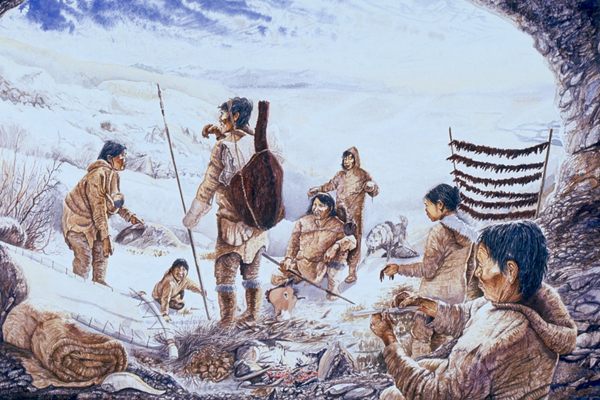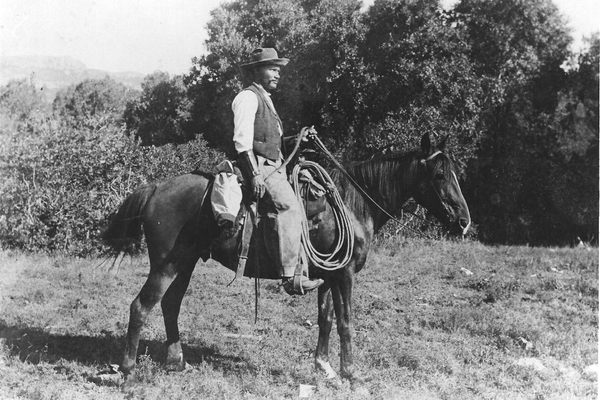The Ancient Secrets Hidden in 41,000 Bison Bones
Thousands of bones from Colorado’s Jones-Miller site offer a detailed picture of Ice Age hunting—and a few mysteries.
This story was originally published on SAPIENS and appears here with permission under a CC BY-ND 4.0 license.
Recently, while giving a tour at the Denver Museum of Nature & Science (DMNS), where I work, I spoke proudly about our collection of materials from the Jones-Miller site in northeastern Colorado. From excavations in the 1970s, the museum holds some 400 tools made from bone and stone, 500 liters of soil, and 41,000 bones of Bison antiquus, an extinct Ice Age bison.
With a hint of disdain, a businessman on the tour asked a simple question: “Why do you need 41,000 bones?”
I had fielded similar questions about the size of museum collections before. Yet this one momentarily stumped me. Why do we need 41,000 pieces of bison skeletons from a single place?
The answer requires revisiting two moments in the past: Going back about 50 years will reveal how and why archaeologists excavated the Jones-Miller site. Traveling 10,800 years before present, we can witness what ancient hunters actually did there.

In 1972, farmer and rancher Robert B. Jones Jr. prepared a field for irrigation and planting. When the backhoe exposed spear points and odd-looking bones, Jones contacted Jack Miller, a former archaeologist at Colorado State University in Fort Collins. Miller dug two large test trenches, but eventually Dennis Stanford of the Smithsonian Institution in Washington, D.C., became involved.
Recognizing the importance of the findings, Stanford assembled a team of archaeologists, geologists, and other scientists to excavate. Prior to beginning, however, Jones informed Stanford that he was going to destroy whatever remained of the site after the scientists finished; he needed the space for his farm.
Archaeologists rarely dig entire sites for budgetary and ethical reasons. Excavation is time-consuming and expensive; it is also destructive. By leaving a portion of a site untouched, future archaeologists can someday use new techniques to learn more about that place. Also, many Tribal Nations consider excavation to be spiritually damaging and dangerous. But since the Jones-Miller site was destined for destruction, Stanford and his team decided to excavate all of it.
In 1973, the researchers laid out a 2-by-2-meter grid across the site, which they knew from earlier test trenches covered roughly 6,000 square meters, about the size of a modern football field. Using elaborate and meticulous techniques, the scientists painstakingly excavated the full area.

Archaeological excavation in the early 1970s was an analog affair. As they uncovered layers of sediment, archaeologists drew maps by hand. They recorded notes on preprinted forms and loose-leaf notebooks. Black-and-white photographs documented most of the excavation; color slides were mostly reserved for publicity shots and landscape views.
Unlike today, there were no drones to snap bird’s-eye view photographs. To capture these shots, the Jones-Miller crew built a pipe and pulley system, dangling a camera above excavated patches.
Although the excavation area was huge, the archaeologists used trowels and brushes—in addition to pickaxes and shovels—because the ground was so densely packed with bison bones. It was slow but exhausting labor in the dry summer heat of the eastern Colorado plains.
Stanford’s crew worked from June through October of 1973, ’74, and ’75. At the end of each season, they shipped tens of thousands of bones, stone tools, soil samples, and field documents back to D.C. Over the ensuing decades, Stanford and his team garnered keen insights about what happened at the site during the waning years of the last ice age.

In 2018, the materials moved to DMNS, where our research team continues the work. From Stanford’s publications and unpublished documents now housed at DMNS, we can sketch out events that took place around the time the last ice age ended on what is today the Jones’ farm. According to recently measured radiocarbon dates, roughly 10,800 years ago, a group of Paleoindian hunters took advantage of the undulating river terrain.
In a shallow draw, or arroyo, the hunters piled branches and shrubs into an arrangement that would channel herd animals in a certain direction. They then chased a nursery herd (cows, calves, and only a few bulls) into the confined arroyo space where the animals could be more easily killed and butchered with spears and stone knives.
Archaeologists who specialize in the study of animal bones can determine the season in which creatures were killed. Assuming ice age bison bred like modern bison, roughly 80 percent of calves were born within a few weeks of each other in the spring. Looking at which teeth the calves had grown, the archaeologists can estimate their age at death—that is, the amount of time since their spring births.
Based on these patterns, it seems the Jones-Miller site contained remains from two kill events: one in spring and one in fall. Unfortunately, we cannot tell if those events occurred during the same or sequential calendar years, the same decade, or even the same century. Radiocarbon dating does not give enough precision.
Archaeologists can also determine how the animals were butchered by studying the patterning of cut marks on the bones. Moreover, at the Jones-Miller site, different bison parts rested in different spots: legs in one pile over here, ribs in another over there, and so on. The spatial distribution of these parts provided clues about how past people made use of the carcasses.
By any measure, butchering a single bison is a feat. Doing so tens or even hundreds of times is a colossal undertaking. Given the abundance of dead bison at the site, it appears the butchers were not terribly interested in conserving meat. On the contrary, based on cut mark patterns, they left some usable body parts behind. The question is why.
Perhaps they simply had an overabundance, more than they could consume. Or they might have intentionally left meat for their carnivore competitors such wolves and coyotes, with whom they shared a complex ecosystem. Indeed, abundant evidence of carnivore gnawing on many of the Jones-Miller bones helps archaeologists understand the complicated relationships between people, other animals, and the rest of the environment as the last ice age gave way to the more comfortable Holocene.

The stone tools people made were beautiful, and beautifully efficient. Their spear points, which archaeologists now call Hell Gap points, tend to be long, slender, and symmetric. They can be resharpened many times if not lost or broken first.
To acquire the stones used to make these tools, people traveled far and wide. Based on distinctive qualities of the rocks, the raw materials came from sources scattered from northern Colorado to eastern Wyoming, from southern Nebraska into northern Kansas, and all the way to west Texas—an area covering nearly 600 miles north-south and 200 miles east-west.
While it is possible that this group traded for some of these materials, population density was likely so low that trade was probably rare. It would have been easier to simply go to the rock sources instead.
The answer to the 41,000–bison bone question is twofold. First, Stanford and his team did the right thing by completely excavating a site they knew was going to be destroyed. Second, by collecting and preserving a comprehensive suite of bones that represent entire herds, in addition to stone tools and other evidence of human activity, we can answer surprisingly detailed questions about happenings on the North American Great Plains 10 millennia ago.

Optimistically, a better understanding of herd dynamics and human-bison interactions in the past may help conservation biologists as they reintroduce modern species of these majestic beasts into the American West.
Robert Jones wanted the Jones-Miller site collection kept in Colorado, so DMNS loaned it to the Smithsonian for over four decades—not only so Stanford’s team could work on the materials, but also because DMNS lacked the necessary storage space.
In 2018, the Jones-Miller site materials returned to Colorado for installation in the museum’s recently built, state-of-the-art collections facility. In 2021, DMNS obtained a Save America’s Treasures Grant from the Institute of Museum and Library Services to hire staff to catalog and rehouse the collection for the first time since it was excavated.
In the coming years, we will build on the Smithsonian team’s myriad efforts to study this remarkable collection—all 41,000 plus pieces.





















Follow us on Twitter to get the latest on the world's hidden wonders.
Like us on Facebook to get the latest on the world's hidden wonders.
Follow us on Twitter Like us on Facebook